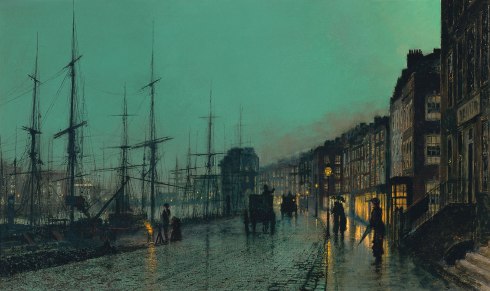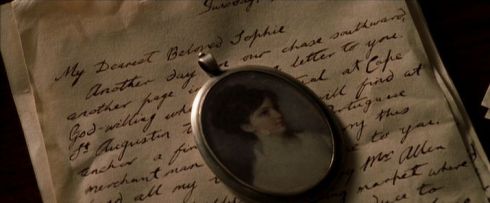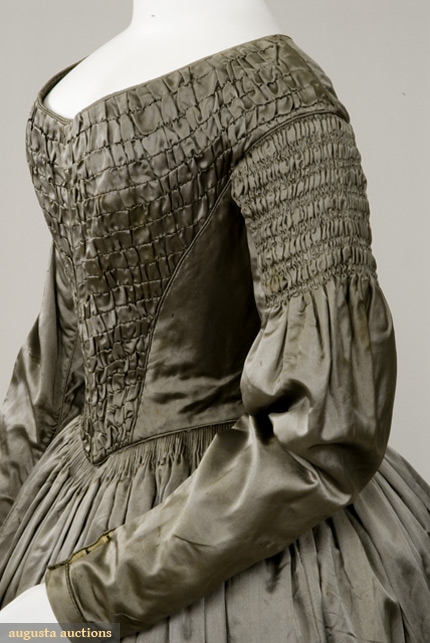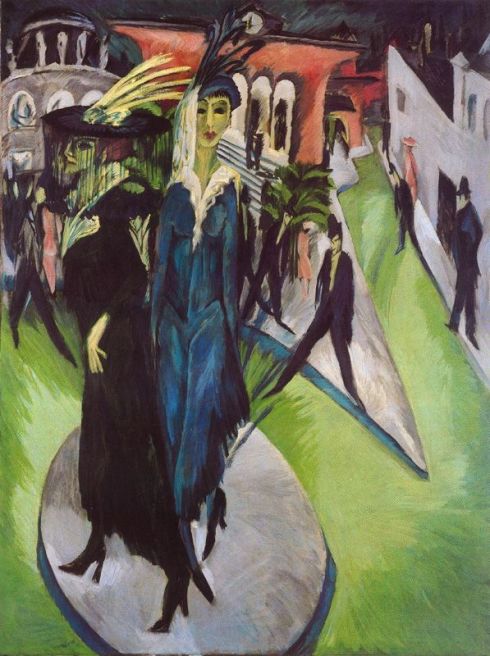I dedicate this post to Frederic Chopin who died on 17th October 1849 and all the other Romantics who ‘ruined’ my life in the most positive way! ___________________________________________________________
Exploration of the inner self lead the Romantics to discover a prodigious world of mysticism, imagination and dreams.
“To romanticize the world is to make us aware of the magic, mystery and wonder of the world; it is to educate the senses to see the ordinary as extraordinary, the familiar as strange, the mundane as sacred, the finite as infinite.”(Novalis)

Romantic era is very appealing to me; all those sad young people that died way too soon, unrequited loves, themes and love towards nature, focus on individuality and imagination,beautiful portraits where ladies’ faces are framed with curls and delicate roses, escapism, melancholy as a state of mind, feeling of alienation.
Every movement in art, music and literature comes as an answer to the previous one and acts as its opposite. Romanticism came as an answer to Classicism and deemed its ‘cult of reason’, coldness, formality and restraint characteristic for the art and literature of the time. In Romanticism an artist is a genious, a gifted person who stands lonely and misunderstood against the meaningless masses. Art itself is originality whereas the principle of Classicism was imitating the Antic models. Romanticism praised the aesthetic function of literature while Classicism valued the educational purpose of it. Artist had more freedom in expressing himself in the Romantic era than in the rigid worldview of Classicism.
In the Romantic era young individuals felt powerless against that rigid regime. Melancholy pervaded the air and the atmosphere of oppressive disappointment after the ideals of equality and justice of the French Revolution were never fulfilled, and the Napoleon’s demise made the society to perceive him as a fallen hero, fallen self-proclaimed hero, which again brought the disappointment. ‘Cult of reason‘ couldn’t and can’t explain the inequality of the world that hurt the young people so much. I find one of Novalis’ quotes very appropriate “Poetry heals the wounds inflicted by reason.” How could rationalism answer the existentialistic questions one might ask oneself? What solution could rationalism have to cure the disappointment of the people with the false social values? Young people; misunderstood poets, artists, musicians and all the other sensitive individuals couldn’t find fulfillment and refuge in rationalistic ideas that were so popular only a century before so they had to find their own way to survive.

In literature this disappointment, unexplainable sadness and melancholy manifested themselves by escaping into solitude and one’s own vision of the world. Those are the sources of the pessimistic worldview, that is the Weltschmerz. ‘World-pain’ or Weltschmerz is an expression for the sense of sadness and despondency induced by discrepancy of reality and ideals. Physical reality can never satisfy the demands of the mind. Weltschmerz resulted in the ‘cult of pain’; a pessimistic sense of how there is no cure for evil in the world. This world pain that caused depression, escapism and resignation as the individual felt powerless against all the injustice in the world, occurred as early as in Rousseau’s (New Heloise) and Goethe’s work (The sorrows of young Werther). However, the world-pain gained its fullest form in works of Byron and Chateaubriand.
Artists of the time felt helpless, sad and disappointed. Surrounded by the tranquil solitude they found comfort in four major themes and preoccupations; intimacy and love, nature (especially exotic landscapes), history and folklore, and mystic and occult. Theme of love and intimacy is the most evident in Goethe’s work The Sorrows of Young Werther, historical themes were the most interesting to Victor Hugo thought he came to the scene a little bit later, and the dark romantic, Edgar Allan Poe is the king of mystical and occult, combing the themes of beauty and death.

Romanticism in English literature begins with the publication of Wordsworth and Coleridge’s collection of poems Lyrical ballads (1798). These two poets, along with Robert Southey, belonged to a group called ‘Lake poets’ for they lived in the Lake district; a picturesque mountainous area in north-west England. William Wordsworth considered poetry as “the spontaneous overflow of powerful feelings,” which he then “recollect[s] in tranquility.” Nature was, however, Wordsworth’s biggest inspiration and he admired it deeply, not only for its aesthetic values; he felt in it the closeness with the sources of life and inexhaustible wellspring of simple and eternal cognition of life. Nature mirrors the state of your soul; romantic poets reflected their feelings into nature, but they also did the opposite, the nature acted on the poets’ sensibility and his inner experiencing. These poets have been very important in setting the ground for the English Romanticism, especially for the second generation of poets.
I must say that I prefer the second generation of English Romantic poets; Byron, Shelley and Keats. Byron, as a person and an artist, is characterised by the fact that in reality he had lived a life of his romantic heroes. His numerous love adventures, travels to exotic lands and the willingness to sacrifice for the ideals of freedom; most importantly, for the freedom of another country – that shows the true nobleness. Byron is responsible for many innovations in poetry and for creating a new type of hero, that is, anti-hero or Byronic hero. Alongside Byron there were two more important poets; Shelley and Keats; both of them cherished a ‘cult of pure beauty’ and both of them died very young in tragic circumstances.

Literary type that emerged from the literature of Romanticism was a romantic hero; a sensitive, courageous and adventurous young man with a great love for nature and everything that is natural, and yet he is unable of controlling his own emotions. He is usually a victim of scheming, mistakes from his youth, his abruptness or his pessimistic attitudes towards life. Typical romantic hero, the best example is young Werther, perhaps even Karl Moor from Schiller’s play The Robbers, does not fit in in society, has a rebellious spirit, can be self-destructive and highly pathetic and excessive in statements.
Other type of romantic hero is Byronic hero, created by Lord Byron. Byronic hero is a man who despises everything and everybody. Though he can have many positive traits like courage or intelligence, he is not noble, kind or humane. He is a cynic and a skeptic, most commonly a materialist and an atheist, often full of contradictions. He loves to live life to the fullest but that desire is usually induced by boredom and a sense of meaninglessness. Byronic hero is a ‘cursed person‘, doing everything that stimulates his own demise. Since Lord Byron was extremely popular with Russian romantic authors, Pushkin was the first to be inspired by the Byronic hero, and derived a similar hero – Superfluous man. It’s a hero who feels superior to his surrounding and yet he submits himself to aimless actions not taking advantage of his potentials. Prone to self destruction, the superfluous man has a strong sense of boredom which compels him to seek oblivion on wanderings and travels. Typical examples include Eugene Onegin and Pechorin from Lermontov’s novel and the first novel of Russian literature – A Hero of our Time.
Romantic hero and Superfluous man are different but they do have similarities such as feeling of alienation and loneliness, intelligence, sensitivity, they both have tendencies towards traveling and excitement and the are fighters against the established social and moral norms.

Though poetry was the most popular form of expressing oneself in Romanticism, it was music that was considered the most romantic of all arts. E.T.A. Hoffman commented on the subject of music ‘The magic of music is so strong, getting stronger, it should break any shackle of another art.‘ Romanticists considered music to be almost like a mind-expanding experience; music revealed unknown areas to man, a word of imagination, a world completely cut out from earthly senses; music was romantic because its theme was the fathomless itself. Music was not only considered to be the most romantic of all arts, but also the spring of all other arts, and therefor lies its true greatness and importance. Novalis also made a remark on music – “Every disease is a musical problem; every cure is a musical solution.”
Beethoven was a musician whose work is considered to mark a transition between Classicism and Romanticism. Other Romantic composers were Frederic Chopin, Franz Liszt, Schumann and Schubert. Romantic musicians were rebellious when it came to themes, they were fascinated by nocturnal, mystic and spooky, longing to the infinite they were inspired by fantastic seeing and spiritual experiences, fascinated by the past, especially Middle Ages, interested in the autobiographical and emphasised extreme subjectivism, at the same time surrendering to nature.

My favourite romantic composer is Chopin; I absolutely adore his Nocturnes; their melody is of greatest melancholy and sadness and yet it possess untamed beauty and mystique. Oscar Wilde commented on Chopin’s music ‘After playing Chopin, I feel as if I had been weeping over sins that I had never committed, and mourning over tragedies that were not my own. Music always seems to me to produce that effect. It creates for one a past of which one has been ignorant, and fills one with a sense of sorrows that have been hidden from one’s tears.‘ Frederick Chopin grew up in Warsaw. His father was French, and Frederick soon moved to Paris, the center of Romanticism in music and the center of arts in general, and as soon as he arrived, his playing style amazed the posh aristocrat audience and gained him admirers. He soon befriended many famous artists and writers of the time; Victor Hugo, H. Balzac, H. Heine, Eugene Delacroix, and also F. Listz all became his friends.
Frederick was elegant and posh, he loved modern and beautiful clothes, champagne, he changed his white gloves every day and traveled in his own carriage. However, he was profound when it came to music and his playing style reflected both great strength and sophistication and sensitivity. ‘It should be like dreaming in beautiful springtime – by moonlight.‘ – he once described his sonata. However, Chopin was of frail health, always thin, weak and melancholic, he died aged thirty nine from consumption. Although befriended with many famous artists of the time, Chopin had a person in Paris he loved even more, it was George Sand with whom had a ten year long relationship. The two met on a party, but Chopin was repelled by her clumsy posture and short, fat, unattractive build. The two met again, two years later; Chopin was in state of melancholy because a young Polish girl had proved unfaithful him, and, devastated, he was improvising a lamentations on a piano when he saw George Sand standing on the doors. His eyes met with her eyes which were black, magical and velvety as the night. After he finished playing, she bent down and kissed him softly. The rest is history.
Romantic era with its emphasis on love and emotions, was an era of many great love stories; Elizabeth Barrett-Browning and Robert Browning, Clara Schumann and Robert Schumann, Mary and Percy Shelley, Lord Byron and Lady Caroline Lamb… the list is endless.
 1781. The Nightmare – Henry Fuseli
1781. The Nightmare – Henry Fuseli
In Romantic era even death was romantic; it was considered a beautiful land of dreams where one could escape the harshness, troubles and greyness of reality. When one sleeps, one dreams and in death one would be dreaming forever, eternally united with nature. In dreams we see our innermost thoughts and desires, and when we die, we would be dreaming forever and ever; death is a dream and one should not be afraid of it. In life, Romantic poets were sad, melancholic, disappointment, alienated, lonely, burdened with social injustices, and powerless against established social and moral norms, and the only comfort and sweetness they could get was sleep; dreams. For Wordsworth, death is nothing more than returning to a more complete and satisfactory existence. Keats considered a death to be an eternal dream which is as beautiful as we create it; death is for him merely a sleep in which one sees the picture they most desire. There are no fears in death, only the ones we create for ourselves. Death is opposite of life, it’s an escape from reality and misunderstanding society, it’s the submerging in nature, becoming a part of the universe again. Life was hard for romantic spiritual philosophy since they lived in times when the Industrial revolution was changing lives and materialism was becoming dominant.
John Keats – ‘On Death’
‘Can death be sleep, when life is but a dream,
And scenes of bliss pass as a phantom by?
The transient pleasures as a vision seem,
And yet we think the greatest pain’s to die.‘
Percy Shelley, mon préféré Romantic poet, was especially fascinated with death and dreams. Highly sensitive, he hated life; its trivialities and the conventionality of society. Extremely devoted to the beauty and peace which he believed could only be found in dreams and death, Shelley was very close to committing suicide, as he felt an enormous ‘death urge‘; he wished to lose all his senses, all attachment from life, all communication with society and emerge himself forever in enormous beauty and magic that death beholds. He wrote a poem ‘A Lament’ in which he expressed his deep desires and longings for death.
‘O World! O Life! O Time!
On whose last steps I climb,
Trembling at that where I had stood before;
When will return the glory of your prime?
No more -Oh, never more!‘

I’m fascinated by deaths in Romantic era, thought people were always dying, and artists died young in many eras, there something so appealing in deaths of Romantic poets, musicians, painters or princesses. Perhaps the shortness of their lives, perhaps the sadness and tranquility that tortured them and maybe even induced their deaths… Shelley, Byron, Keats, Schubert – they all died young, but tragic and romantic death did not spare the members of aristocracy either, particularly interesting to me are Russian Grand Duchesses, sisters Alexandra and Elena Pavlovna who died very young; Alexandra died aged seventeen and Elena was just a year older when she succumbed to her eternal sleep. Later, Grand Duchess Alexandra Nikolaevna died aged only nineteen. In her portraits, she gazes at the viewer with a hint of melancholy and resignation, dressed in elegant satin, while her pale skin shows the beauty of her innocence, her stately neck stands as if it was fragile as a feather, carrying a beautiful face crowned with dark hair in braids. Aura of sadness followed Alexandra on her portraits like a shadow.
P.S. I wrote this post exactly one year ago but due to the connection between Autumn and Romanticism, and my current obsession with Romanticism, I decided to re-post it.
Tags: Byronic hero, Eugene Onegin, Frederic Chopin, George Sand, Goethe, Keats, Lake Poets, Lermontov, Lord Byron, Pechorin, Percy Shelley, Pushkin, Romantic era, Romanticism, Russian literature, Shelley, Superfluous man, The Nightmare - Henry Fuseli, The Sorrows of Young Werther, William Wordsworth







 Evening in the park by Ernst Vikne on Flickr.
Evening in the park by Ernst Vikne on Flickr.




































































































